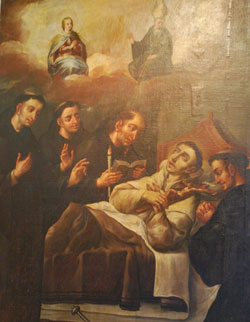
Feastday: March 18
Birth: 1520
Death: 1567
Beatified: February 5,1606 by Pope Paul V
Canonized: April 17, 1938 by Pope Pius XI
St. Salvatore of Horta (Feast day - March 18th) St. Salvatore is usually described as "of Horta" because he spent many years in the Franciscan Friary of that place. He was born at Santa Columba in the diocese of Gerona in Spain. He came of a poor family, and lost both his parents while still a child. Migrating to the town, he worked as a shoemaker in Barcelona. At the age of twenty, as his heart was set on the religious life, he became a Franciscan of the Observance. Employed in the kitchen, his virtue quickly matured in these humble surroundings, but he thirsted for greater austerity, and passed on, first to the convent of St. Mary of Jesus at Tortosa, and then to the solitude of St. Mary of the Angels at Horta in the same diocese. In that house of very strict observance, he made a protracted stay but eventually he returned to Barcelona, where his supernatural gifts attracted much notice, and where the blind, lame and deaf came to him to be healed. He always walked barefoot, scourged himself daily, and kept long and rigorous fasts. He was specially devoted to our Lady and to St. Paul who appeared to him on several occasions, notably on his death-bed. St. Salvatore had gone to Sardinia in compliance with the orders of his superiors when he was seized with an illness which proved fatal. He died at Cagliari, being forty-seven years of age, in 1567. He was venerated as a saint during his lifetime and was eventually canonized in 1938.
Christian saintSalvador of Horta, O.F.M., (Catalan: Salvador d'Horta, Spanish: Salvador de Horta, Italian: Salvatore da Horta) was a Spanish Franciscan lay brother from the region of Catalonia in Spain, who was celebrated as a miracle worker during his lifetime. He is honored as a saint by the Catholic Church.
Life
He was born Salvador Pladevall i Bien some time during December 1520 in the hospital of Santa Coloma de Farners, located in the Catalan Province of Girona, where his parents worked as servants. Orphaned at age 14, he moved with his sister Blasa to Barcelona, where he worked as a shoemaker to support them both.
When his sister had married, Pladevall felt free to follow a religious calling he had felt. He first entered the famed Benedictine Abbey of Santa Maria de Montserrat, near Barcelona, to explore monastic life. Apparently not feeling drawn there, and desiring a more humble way of life, he entered the novitiate of the Observant branch of the Order of Friars Minor in Barcelona as a lay brother on 3 May 1541. He made his profession of vows in 1542, having become known among the friars for his asceticism and humility.
Salvador was then sent by his superiors to serve as the cook, designated beggar and porter at the friary at Tortosa. There Salvador soon acquired a reputation as a healer, and the friary became a destination for sick pilgrims. It was estimated by observers that the number of visitors to the friary numbered some 2,000 people per week.
As a result, Salvador's superiors developed a suspicion of him which was to shadow him for the rest of his life, and they began moving him to different friaries: first Bellpuig, then Lleida, followed by the remote village of Horta de Sant Joan, the town with which he is most identified, residing there 1547-1559 in the Friary of Our Lady of the Angels. Salvador was eventually moved to the friary of Reus and again to Madrid, where he was visited by King Philip II of Spain, followed by yet another move to the friary in Barcelona. While residing there, in 1560 he was denounced to the Spanish Inquisition for the many miracles attributed to his intercession. After some investigations, they chose to take no action against him.
In 1565 Salvador was assigned to the Friary of St. Mary of Jesus in Cagliari, on the island of Sardinia, then under the rule of Spain, where he continued to serve as the cook for the community. He also continued to have cures take place at his intercession. It was there that he died on 18 March 1567.
 Remains of the cloister of the Franciscan friary in Horta de Sant Joan, where St. Salvador lived for twelve years.
Remains of the cloister of the Franciscan friary in Horta de Sant Joan, where St. Salvador lived for twelve years.
Veneration
At the request of King Philip, Salvador was allowed to be venerated as "Blessed" on 5 February 1606 by Pope Paul V, which was confirmed on 29 January 1711 by Pope Clement XI. He was canonized on 17 April 1938 by Pope Pius XI. His feast day is generally celebrated on 18 March, the anniversary of his death; it is observed, however, by the Friars Minor on 17 April, the anniversary of his canonization.
His remains were originally interred at the Church of St. Mary of Jesus attached to the friary where he died. In 1606 it had been decided to open his grave to provide his heart as a relic for the Franciscan community in Silke, near Sassari. When it was opened, his body was found to be still intact. Thus, when the Church of St. Mary of Jesus was demolished in 1718, his remains were interred first at another church of the Order in the city, then finally, in 1758, they were entombed in a glass coffin under the main altar of the Church of St. Rosalie in the city. This remains his shrine, where his remains can be venerated.
Veneration of Salvador spread throughout his native Catalunya and also in Calabria, long under Spanish rule.





